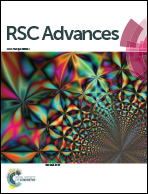Reliable resistive switching memory based on oxygen-vacancy-controlled bilayer structures†
Abstract
We fabricated resistive random access memory (RRAM) devices composed of a bilayer of AlOx. The AlOx layer was synthesized by atomic layer deposition (ALD) with different oxidizer sources. To control the number of oxygen vacancies, we used water and ozone as the oxidizer sources in ALD. The AlOx layer synthesized using water as the oxidizer source (AlOx(water)) contained more oxygen vacancies than the AlOx layer deposited using ozone as the oxidizer (AlOx(ozone)). We fabricated memory devices with a structure of Al/AlOx(water)/AlOx(ozone)/Pt by ALD. After the initial forming process the devices showed reproducible and reliable RRAM characteristics. Bipolar resistive change was observed in Al/AlOx(water)/AlOx(ozone)/Pt RRAM devices with low operation voltages of less than 1 V. Ohmic conduction behavior was dominant in the low resistance state and trap-controlled space-charge-limited conduction was observed in the high resistance state. The resistive switching is related to migration of oxygen vacancies and the formation/rupture of conductive filaments. Oxygen vacancies formed conductive filaments when an electric field was applied, and Joule heating broke them. The reliability of the devices was confirmed by data retention and endurance tests. The reliable bipolar resistive switching properties are attributed to a stable conductive filament in the AlOx(water) layer and partial connection/disruption of a conductive filament localized at the AlOx(ozone) layer.


 Please wait while we load your content...
Please wait while we load your content...